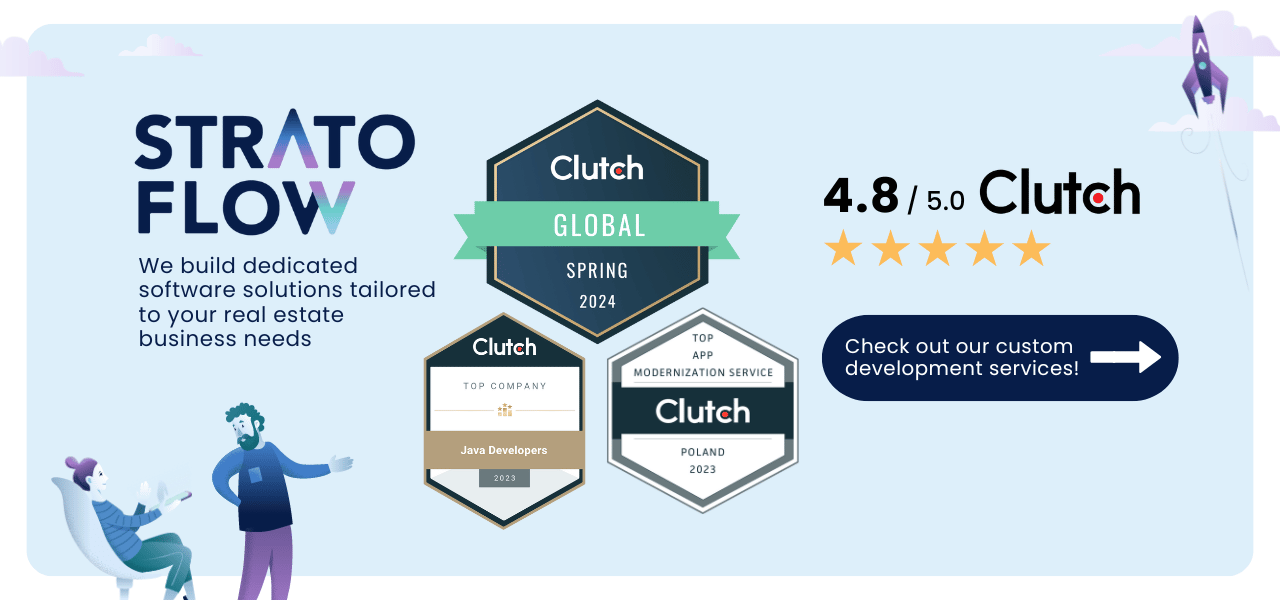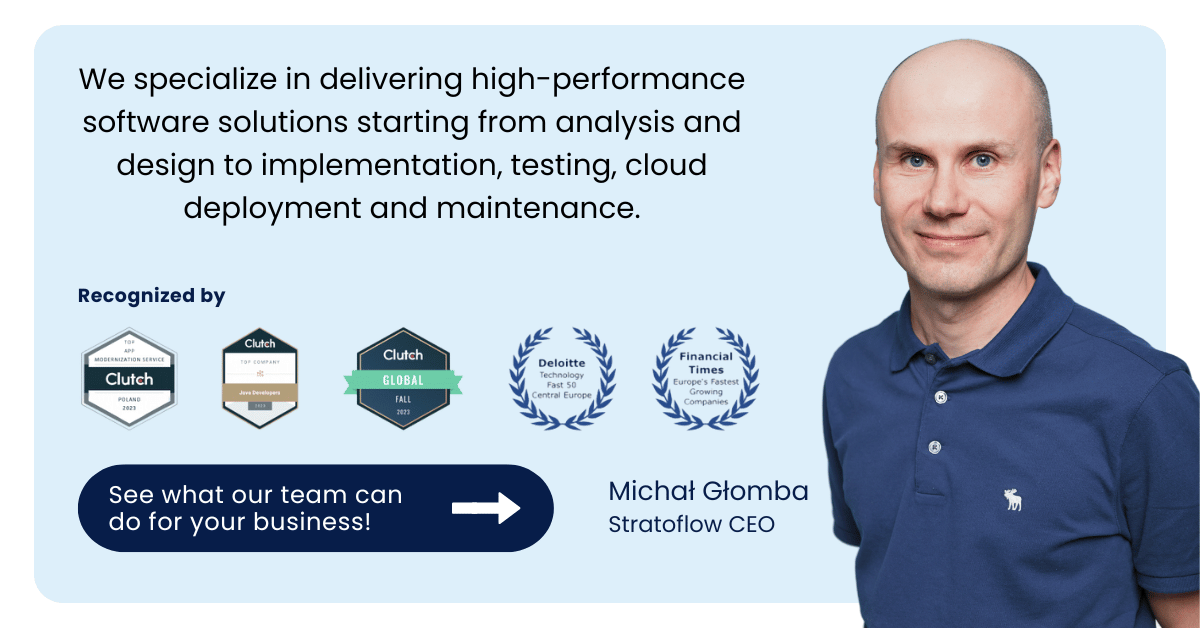
AI-Powered Recommendation Engines for Modern Business
In 2025, AI technology is all the rage, but nowhere is it more established than in recommendation engines.
These AI-powered systems are revolutionizing the way businesses interact with their customers, delivering personalized suggestions that improve the user experience and drive sales.
From e-commerce to media and entertainment, recommendation engines are proving to be invaluable tools for driving engagement and revenue.
In this article, we’ll explore what AI recommendation systems are, their key use cases, the technology behind them, and best practices for developing and integrating these powerful tools.
Contents
- What Is an AI-powered Recommendation System?
- Top Use Cases of AI-based Recommendation Systems
- Deploying Custom Recommendation Engine in Your Business
- How AI Recommendation Engine Works: Lesson Learned From Working on Recostream
- Key Benefits of Recommendation Systems
- Good Practices for Integrating a Recommendation Engine: Tips from Experts
- Importance of Personalization For Other Industries
What Is an AI-powered Recommendation System?
An AI-powered recommendation engine is a sophisticated technology designed to provide users with relevant recommendations based on their preferences and behaviors.
These recommendation engines use advanced algorithms to analyze user data, including past interactions, search history, and demographic information.
As a result, they can predict and suggest products, services, or content that a user is likely to enjoy.
For example, when you browse an online retail site like Amazon, the system recommends products that match your browsing and purchasing history, enhancing your shopping experience and increasing the likelihood of a purchase.
This ability to provide personalized suggestions makes AI-powered recommendation systems invaluable to businesses looking to improve customer satisfaction and increase sales.
Top Use Cases of AI-based Recommendation Systems
AI-powered recommendation engines are transforming industries by providing tailored suggestions and improving the user experience.
Let’s explore how these systems are being used in various fields.
Ecommerce
AI recommendation engines have become indispensable in the ecommerce space, significantly improving customer engagement and driving revenue growth.
By analyzing vast amounts of customer data, such as browsing history, search queries, and past purchases, these engines provide highly personalized product suggestions based on individual preferences.
The impact of AI-driven recommendations on e-commerce is significant.
For example, 35% of Amazon’s revenue comes from its AI-powered recommendation system.
For a seemingly minor addition to the store’s interface, the impact of AI recommendations on Amazon’s sales is remarkable.

In addition, AI-driven personalization can increase online retail sales by up to 15% and significantly improve customer satisfaction.
Retailers using AI report a 45% improvement in customer retention rates, underscoring the effectiveness of personalized shopping experiences in driving customer loyalty.
AI’s role in e-commerce is also rapidly expanding.
By 2025, AI is expected to power 95% of ecommerce customer interactions, demonstrating the critical role these technologies will play in future business strategies.
Notably, 83% of companies have prioritized AI adoption in their business strategies, underscoring the widespread recognition of AI’s potential to revolutionize customer engagement and operational efficiency.

Media and Entertainment
The media and entertainment industry is using AI-powered recommendation systems to keep users engaged by suggesting content that matches their tastes.
Platforms such as Netflix and Spotify use sophisticated algorithms to analyze viewing and listening habits.
This ensures that users spend more time on the platform, increasing subscription rates and advertising revenue.
According to Netflix, their recommendation system saves them over $1 billion annually by reducing churn and keeping subscribers happy with personalized content suggestions.
[Read also: Online Shopping Recommendations – How to Introduce Them in Your Business?]
Travel
In the travel industry, AI-based recommendation systems enhance the customer experience by providing tailored travel suggestions, including destinations, accommodations, and activities.
Companies such as Expedia and Booking.com use these recommendation systems and collected customer data to analyze user preferences and past bookings to offer relevant travel packages.
This not only improves customer satisfaction, but also increases bookings.
According to PwC’s research, nearly 30% of consumers express a higher likelihood to book through an agency if it offers AI-driven personalized website content catering to their interests
Finance
Financial services leverage AI recommendation engines to provide personalized financial advice and product suggestions.
These systems analyze customer data, including transaction history and financial goals, to recommend suitable investment opportunities, credit cards, and insurance products. This personalized approach helps in building customer trust and loyalty.
For example, fintech companies report increased customer engagement and retention when using AI-driven financial recommendations
Advertising
In advertising, AI-powered recommendation engines optimize ad placements by analyzing user behavior and preferences.
This ensures that ads are shown to the right audience at the right time, increasing the likelihood of conversion.
Companies like Google and Facebook use AI to deliver targeted ads, resulting in higher click-through rates and advertising revenue.
Studies indicate that personalized ads can improve conversion rates by up to 40% and the global market revenues from AI usage in marketing are expected to reach 36 billion U.S. dollars in 2024.
Deploying Custom Recommendation Engine in Your Business
Want to achieve the same results in your own business?
A custom recommendation engine could be the solution you are looking for.
At Stratoflow, we have extensive experience and expertise in developing custom AI-powered recommendation engines.
Our flagship product, Recostream, exemplifies our capabilities in this area.
Recostream is a state-of-the-art AI/ML-powered recommendation engine designed to provide highly accurate and real-time product suggestions for e-commerce platforms.
Our talented software engineers have built Recostream from the ground up, ensuring that it can handle large-scale data processing and deliver personalized recommendations in milliseconds.
This ensures a seamless user experience, as most recommendations are generated within 20-30 milliseconds.
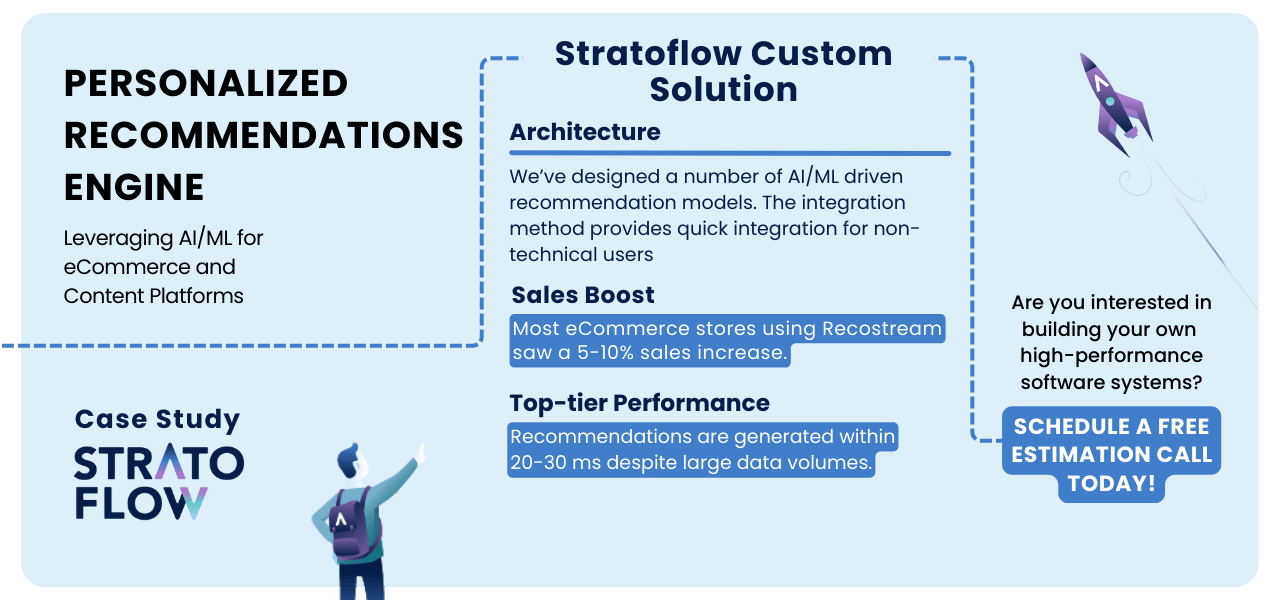
Recostream’s impact on sales has been significant. E-commerce stores using our recommender system have seen a 5-10% increase in sales due to the personalized recommendations it provides.
In addition, the integration process is straightforward, often requiring only a single line of code, allowing for rapid deployment without disrupting existing systems.
At Stratoflow, we are committed to helping businesses harness the power of AI to drive growth and improve the customer experience.
Don’t let your ecommerce business fall behind in the accelerating AI revolution and introduce personalized recommendations that will drive sales and improve other KPIs.
At Stratoflow, we can build a custom recommendation engine tailored specifically to your e-commerce business. Compared to out-of-the-box solutions, a custom engine offers several key benefits:
- Enhanced Personalization: A custom solution can be fine-tuned to your specific business needs, ensuring the recommendations are as relevant and personalized as possible.
- Scalability: Our custom engines are built to handle large volumes of data and high user traffic, ensuring consistent performance even during peak times.
- Integration Flexibility: We can seamlessly integrate the recommendation engine with your existing systems, minimizing disruption and maximizing efficiency.
- Continuous Improvement: We offer ongoing support and optimization, ensuring the recommendation engine evolves with your business and market trends.
Whether you are in e-commerce, media, entertainment, or any other industry, our expertise in building custom AI-enabled recommendation engines can be a game-changer for your business.
Contact us to discuss how we can tailor our software solutions to meet your specific needs and achieve your business goals.
How AI Recommendation Engine Works: Lesson Learned From Working on Recostream
The process of AI-powered recommendation engines is quite detailed and involves several key steps.
It starts with collecting user data, which is done through cookies and other tracking tools that monitor user interactions on websites. This data includes what users click on, what they search for, and their browsing and purchase history.
The goal is to build a detailed profile of each user’s preferences and behavior.
Once the data is collected, it goes through a detailed analysis.
Advanced algorithms such as matrix factorization are used to find patterns and relationships in the data. Matrix factorization helps break down large amounts of user-item interaction data into simpler pieces, making it easier to see the hidden factors that influence user preferences.
This analysis transforms raw data into useful insights.
These insights help predict what products or content a user might like. The recommendation engine then uses these predictions to generate a list of personalized recommendations. These suggestions are presented to users in real time, ensuring that they are timely and relevant.
An essential part of this process is continuous learning and improvement.
As users interact with the recommendations, their actions provide feedback. This feedback loop helps the system refine its suggestions, maintaining accuracy and effectiveness over time.
There are three main ways that AI recommendation engines process data to drive sales and user engagement.
Let’s take a closer look at them and see how we used them in our work on Recostream.
Collaborative Filtering Algorithms
Collaborative Filtering (CF) is one of the most common techniques used in recommendation engines.
It works by analyzing the preferences and behaviors of multiple users to find patterns and similarities.
There are two main types of collaborative filtering: user-based and item-based.
User-Based Collaborative Filtering
User-based collaborative filtering systems recommends items based on the similarity between users. Here’s how it works:
- Identify Similar Users: The algorithm finds users who have similar tastes by comparing their past interactions (ratings, clicks, purchases).
- Recommend Items: Once similar users are identified, the system recommends items that these similar users have liked but the current user has not interacted with yet.
For example, if User A and User B have both liked several of the same movies, and User A liked a movie that User B has not seen, that movie might be recommended to User B by the movie recommendation system.
Item-Based Collaborative Filtering
Item-based collaborative filtering focuses on the relationship between items instead of users. The steps include:
- Identify Similar Items: The algorithm looks for items that have been liked by similar users.
- Recommend Items: The system then recommends items that are similar to those the user has liked in the past.
For instance, if many users who bought a specific book also bought another book, then these two books are considered similar. If a user buys the first book, the second book will be recommended to them.
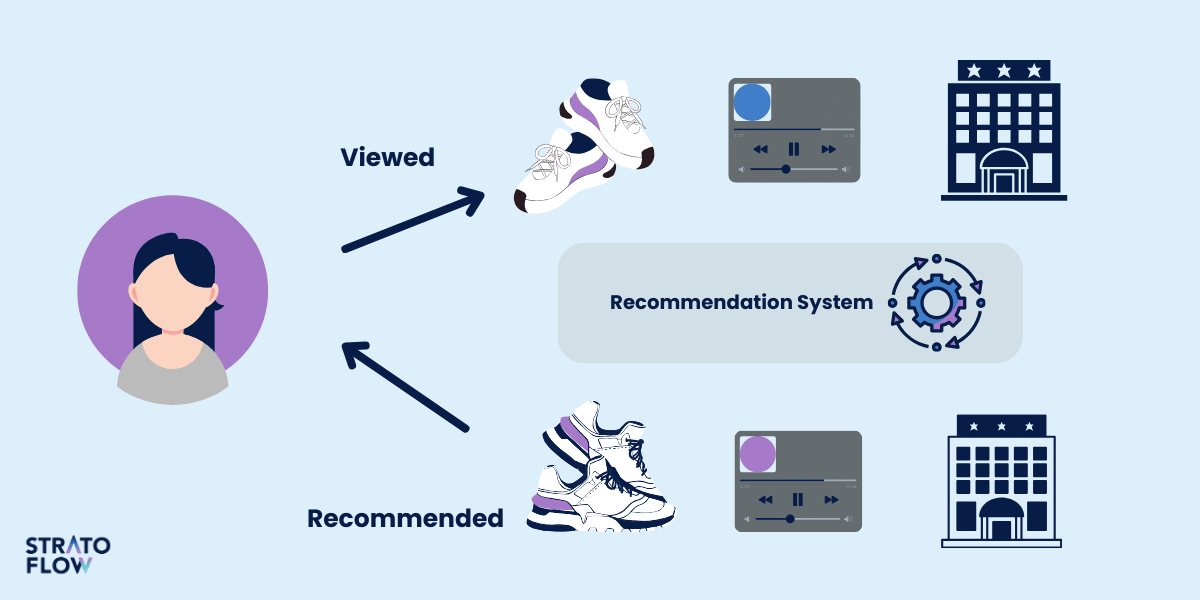
Insights from Our Experience
At Stratoflow, we implemented a collaborative filtering model for a women’s clothing store.
By analyzing the purchase histories of different customers, we identified patterns that allowed us to suggest complementary products.
For example, when a user added a dress to her shopping cart, the system would recommend accessories or shoes that other users often purchased with that dress.
This model was integrated into both the product page and the checkout page, resulting in increased sales and a higher average order value.
Content-Based Filtering Algorithms
Content-based filtering (CBF) recommends items based on the attributes of the items and the user’s past interactions with similar items.
This method uses information about the products, such as descriptions, features, and specifications, to find similarities between different items.
Content-based filtering is another key method used in AI recommendation engines.
Unlike collaborative filtering, which relies on user behavior and preferences, content-based filtering focuses on the attributes of items and the preferences of individual users.
The goal is to recommend items that are similar to those in which the user has expressed an interest, based on item characteristics.
How Content-Based Filtering Works
- Item Profiling: Each item in the system is described by a set of attributes. For example, in an online bookstore, attributes might include genre, author, publication date, and keywords from the book’s description.
- User Profiling: The system creates a profile for each user based on their past interactions. This profile is built from the attributes of items the user has previously liked or interacted with.
- Matching: The algorithm matches the user profile with item profiles to find and recommend items that share similar attributes to those the user has liked before.
Example of Content-Based Filtering
Consider an electronics store.
The store’s inventory includes products with various specifications such as brand, model, price, technical specifications (e.g., processor type, RAM size, storage capacity), and customer ratings.
Here’s how content-based filtering might work in this context:
- Item Profiling: Each electronic item, such as a laptop, is characterized by its attributes—brand (Dell, HP, Apple), processor (Intel i5, AMD Ryzen 5), RAM (8GB, 16GB), storage (256GB SSD, 1TB HDD), and so on.
- User Profiling: If a user frequently views or purchases laptops with specific attributes (e.g., Dell laptops with Intel i7 processors and 16GB RAM), the system builds a user profile highlighting these preferences.
- Recommendation Generation: The recommendation engine then suggests other laptops that have similar specifications, ensuring the user sees products that align closely with their known preferences.
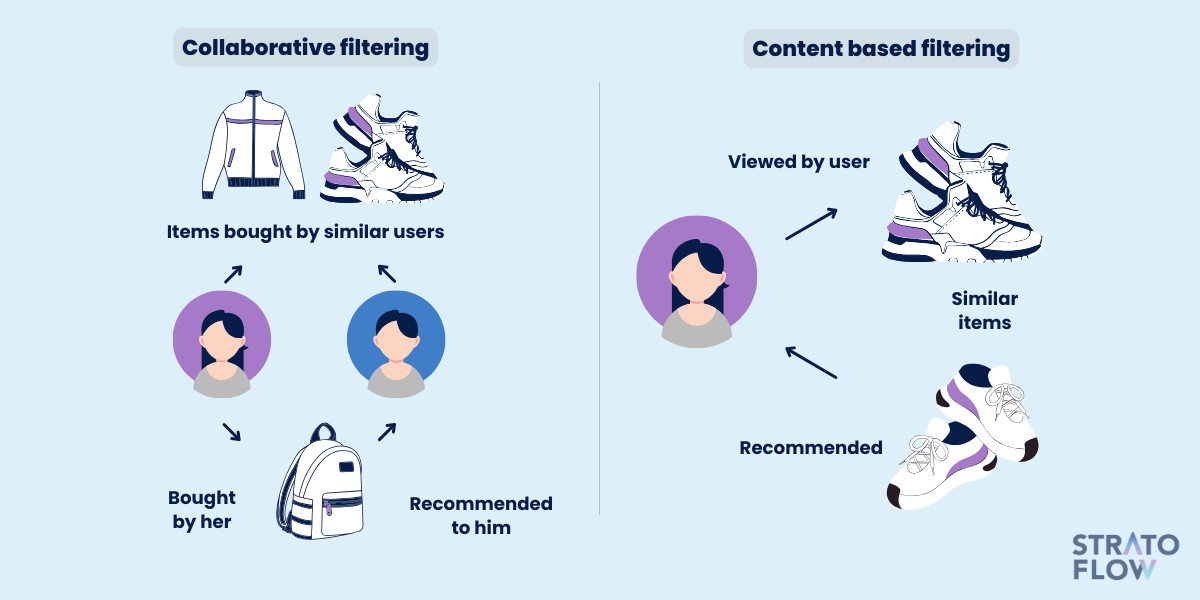
Insights from Our Experience
When working on recommendation for an electronics store, we developed a content-based filtering model that compared various product specifications.
If a user was looking at a particular smartphone, the system would recommend other smartphones with similar features, such as screen size, battery life, and camera quality.
This approach ensured that users could easily find products that met their specific needs and preferences, thereby enhancing their shopping experience.
Hybrid Models
Hybrid models in AI recommendation systems combine the strengths of collaborative filtering and content-based filtering to provide more accurate and diverse recommendations.
These models aim to mitigate the limitations of each approach by integrating their complementary benefits to improve overall recommendation quality.
Hybrid models leverage the user interaction data used in collaborative filtering and the item attribute data used in content-based filtering.
This combination allows the system to generate recommendations that are both personalized based on user behavior and relevant based on item attributes.
For example, a hybrid model might first use collaborative filtering to identify a set of items preferred by similar users, and then use content-based filtering to refine those suggestions based on the specific attributes that match the target user’s preferences.
Key Benefits of Recommendation Systems
AI-powered recommendation systems offer numerous advantages that enhance both user experience and business performance.
By leveraging sophisticated algorithms to provide personalized suggestions, these systems help bridge the gap between user preferences and product offerings.
Below are some of the key benefits of implementing recommendation systems:
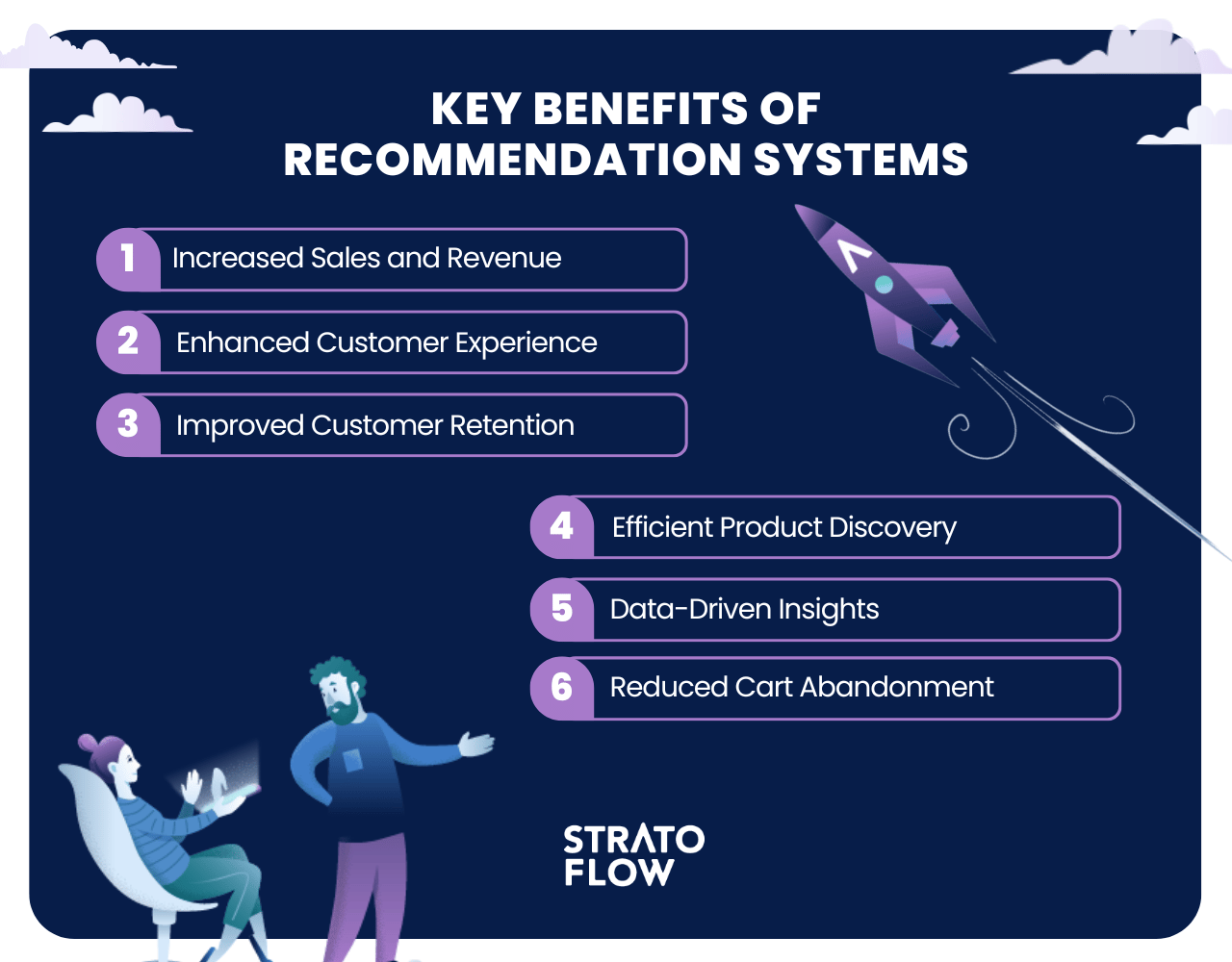
- Increased Sales and Revenue: Personalized recommendations lead to higher conversion rates and larger average order values. By suggesting products that align with user preferences, businesses can encourage additional purchases and boost overall sales.
- Enhanced Customer Experience: Providing relevant and timely product recommendations improves the shopping experience, making it easier for users to find products they are interested in. This personalized approach increases user satisfaction and loyalty.
- Improved Customer Retention: By continuously offering products that match user preferences, recommendation systems help retain customers. Satisfied customers are more likely to return to the platform, thereby increasing customer lifetime value.
- Efficient Product Discovery: Recommendation engines help users discover new products they might not have found on their own. This enhances product visibility and promotes the exploration of a broader range of items.
- Data-Driven Insights: These systems collect and analyze vast amounts of user data, providing businesses with valuable insights into customer behavior and preferences. This information can be used to refine marketing strategies and product offerings.
- Reduced Cart Abandonment: By offering relevant suggestions and personalized offers, recommendation systems can help recover abandoned carts. Targeted follow-up emails with product recommendations can encourage users to complete their purchases.
By harnessing the power of AI, businesses can uncover new opportunities for growth, build stronger customer relationships, and stay ahead in an increasingly competitive marketplace.
By 2026, such systems will be standard across many industries. The biggest differentiators will be the quality of your AI recommendation engine and how well it’s integrated into your company’s operations.
And that’s where the knowledge of experts in the field becomes indispensable.
Good Practices for Integrating a Recommendation Engine: Tips from Experts
Drawing from our extensive experience with Recostream, here are some expert tips from Stratoflow developers on how to effectively develop and integrate AI-driven recommendation engines.
These practices will help ensure that your recommendation system is both efficient and effective.
Tip #1: Gather Useful Insights from Your Recommendations
One of the most valuable aspects of an AI recommendation engine is its ability to collect and analyze data to drive business decisions.
Having a dedicated dashboard to monitor the performance of your recommendation engine is critical.
A comprehensive dashboard allows you to track key metrics such as click-through rates, conversion rates, and average order value in real time. This visibility into your system’s performance helps you identify trends and anomalies that can inform your strategy.
In addition, by collecting and analyzing statistical data, you can gain deeper insights into user behavior and preferences. This data is invaluable for refining your algorithms to improve the accuracy of recommendations.
Tip #2: Remember About Performance
The performance of your recommendation engine is critical to maintaining a smooth and engaging user experience.
Generating recommendations within milliseconds is essential to avoid frustrating delays that could drive users away.
- Real-Time Processing: Ensure that your recommendation system can process and generate recommendations in real-time. This means optimizing your algorithms and infrastructure to handle large volumes of data quickly.
- Low Latency: Aim for a latency of 20-30 milliseconds for generating recommendations. This ensures that users receive suggestions almost instantly, which is crucial for maintaining a seamless browsing experience.
- Scalability: Design your system to scale efficiently as your user base grows. This involves using scalable cloud solutions, multitanand database approach and distributed computing to manage increased loads without compromising performance.
- [Read also: Essential Reading: 7 Best Books & 4 Research Papers on Machine Learning Recommender Systems]
Tip #3: Don’t Forget About the Cold Start Issue
The cold start issue refers to the challenge of making accurate recommendations for new users or with new items when there is little to no interaction data available.
Addressing this issue requires a strategic approach.
- Hybrid Models: Utilize hybrid recommendation models that combine collaborative and content-based filtering. This approach allows the system to rely on item attributes when user interaction data is sparse.
- Default Recommendations: Implement default recommendations based on popular or trending items for new users. These can provide a starting point until the system gathers enough data to personalize suggestions.
- User Onboarding: You can try collecting initial preferences during user onboarding. Asking new users to select a few interests or preferences can help jumpstart the recommendation process. This would not work in every scenario but Spotify has shown how such approach can very efficiently provide necessary data to machine learning algorithms to generate quality recommendations right of the bat.
By proactively addressing the cold start issue, you can ensure that your recommendation engine provides value to all users, regardless of their interaction history.
Related Posts
- Inside the Netflix Algorithm: AI Personalizing User Experience
- Music Recommendation System: How Do Streaming Platforms Use AI?
- How to Use Ecommerce Recommendations to Drive Sales?
- Complementary Products: A Way to Increase Your Online Store Sales
- Custom Recommendation Engines: What They Are and How to Use Them
Thank you for taking the time to read our blog post!

